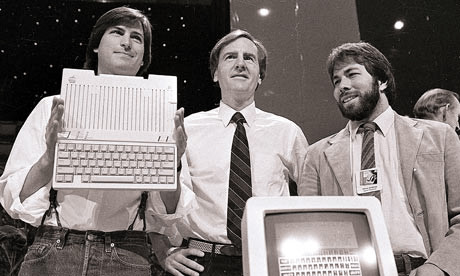The Apple II holds a special place in the hearts of many, especially those who experienced the dawn of personal computing. During my most active years with the Apple II, communities like Softalk magazine and the Open-Apple newsletter were vital. Softalk offered balanced coverage of all Apple products, fostering a neutral perspective towards the Apple II, Apple III, Macintosh, and Lisa. For me, primarily an Apple II user, any content beyond the Apple II was simply informative, expanding my understanding of Apple’s broader ecosystem.
When Softalk ceased publication, I quickly gravitated towards Tom Weishaar’s Open-Apple newsletter. Weishaar, a former DOSTalk columnist, brought a more opinionated voice, particularly regarding his deep affection for the Apple II. His newsletter also introduced me to the A2 Roundtable on GEnie in the late 1980s. In these online and print communities, a recurring theme was the growing frustration with Apple’s perceived neglect of the Apple II. We, the Apple II enthusiasts, felt sidelined by Apple’s apparent infatuation with the Macintosh, a machine we considered underpowered compared to the versatile and efficient Apple II. Weishaar’s connections within the Apple II division provided glimpses into the internal dynamics at Apple, highlighting the perceived disparities between the Mac/Lisa and Apple II groups. Immersed in these communities, I adopted a critical stance towards Apple’s management, blaming them for the shrinking Apple II user base.
 Steve Jobs, John Sculley, and Steve Wozniak at the Apple IIc introduction. Photo credit: Sal Veder/AP
Steve Jobs, John Sculley, and Steve Wozniak at the Apple IIc introduction. Photo credit: Sal Veder/AP
Following Steve Jobs’ departure in 1985, John Sculley took the helm as CEO of Apple. In our eyes, John Sculley became the central figure responsible for what we perceived as Apple’s abandonment of the Apple II. Despite the Apple II division continuing to produce remarkable software like AppleWorks, ProDOS, and GS/OS, demonstrating impressive efficiency from an aging architecture, Apple seemed to downplay the platform. Computer publications frequently predicted the Apple II’s imminent demise, and Apple’s silence on these predictions only fueled our frustration. Like many in the Apple II community, I harbored resentment towards Apple, the Macintosh, and John Sculley for the perceived mistreatment of my preferred computer. My feelings even manifested in a parody song, “Apple II Pie,” where I replaced “Satan” with “Sculley,” symbolically casting him as the orchestrator of the Apple II’s downfall.
Revisiting John Sculley’s Apple Strategy
This negative perception of John Sculley led me to disregard his autobiography, Odyssey, and any narratives that presented him in a positive light. However, a recent two-part interview with John Sculley conducted by David Greelish of Classic Computing and Retrocomputing Roundtable podcasts has prompted a significant shift in my understanding. In this interview, Sculley revealed a crucial detail about his early days at Apple: Steve Jobs, upon Sculley’s arrival, was prepared to immediately discontinue the Apple II line, prioritizing the Macintosh.
Sculley, drawing upon his extensive business acumen, recognized the catastrophic financial implications of such a decision in 1983. Neither the Macintosh nor the Lisa had yet achieved the market penetration necessary to sustain Apple’s revenue streams. Sculley argued that abruptly ending the Apple II, Apple’s primary income source at the time, would have severely jeopardized the company’s future.
John Sculley’s Support for the Apple II
John Sculley emphasized that a primary focus during his initial years as CEO was to ensure the Apple II’s continued profitability. This strategic move was designed to provide the Macintosh division with the time and resources needed to mature and become a viable profit center itself. To demonstrate his commitment to the Apple II division, Sculley deliberately located his office in the Triangle Building, the same off-campus facility housing the Apple II team. He actively engaged with the division, bringing in Bill Campbell for marketing expertise and appointing Del Yocam as its leader.
Under Sculley’s leadership, the Apple II product line saw significant advancements, including the releases of the Apple IIc, Apple IIGS, Apple IIc Plus, and the Enhanced Apple IIe. Furthermore, the operating system evolved with ProDOS 16 and GS/OS for the IIGS, enhancing the platform’s capabilities. These efforts proved successful, bolstering Apple’s cash flow and partially offsetting the market share gains made by IBM PC and the MS-DOS ecosystem.
A Change of Perspective and Public Apology to John Sculley
These previously unconsidered facts have compelled me to reassess my judgment of Mr. Sculley. I now understand the strategic rationale behind his decisions regarding the Apple II. While the eventual discontinuation of the Apple II line, starting with the Apple IIGS and later the Apple IIe, was undoubtedly painful for loyal users, historical perspective suggests these were necessary business choices. Looking back twenty years later, it’s clear that these decisions, though difficult, were ultimately in the best interest of Apple’s long-term survival and growth. As the saying goes, “it was not personal, it was strictly business.” However, at the time, we, the passionate Apple II community, took it very personally.
Therefore, I extend a public apology to Mr. John Sculley. My past criticisms, born from a place of Apple II devotion and limited understanding of the broader business context, were misplaced. John Sculley, in reality, acted as a friend to the Apple II, ensuring its survival during a crucial transition period for Apple, even if we didn’t recognize it then. He navigated Apple through a complex phase, balancing the legacy of the Apple II with the promise of the Macintosh, ultimately shaping the company’s trajectory towards future success.
